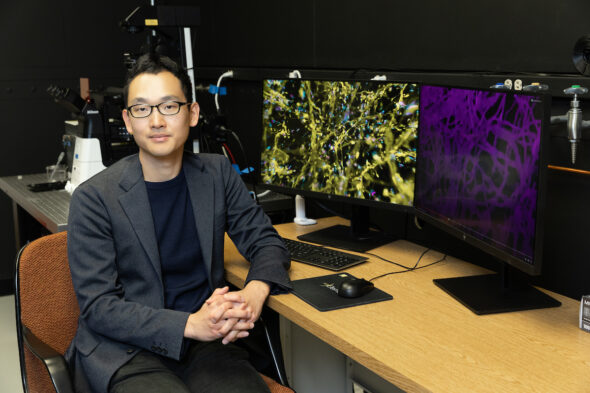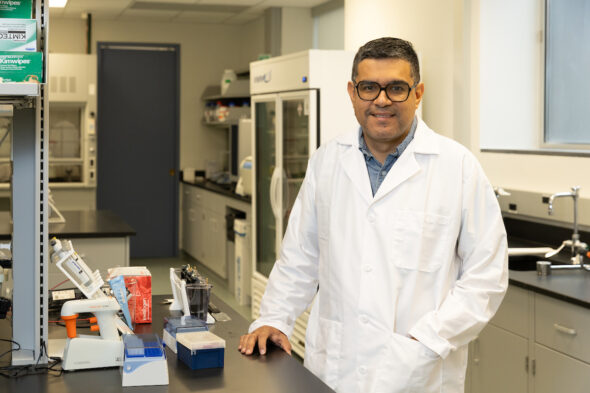Early career researchers first from UIC to receive NIH New Innovator awards
University of Illinois Chicago researchers Ruixuan Gao and José Villegas received New Innovator awards from the National Institutes of Health to fund high-risk, high-reward research at the cutting edge of science.
Gao, an assistant professor with a joint appointment in the chemistry and biological sciences departments, received the NIH Director’s New Innovator Award from the NIH Common Fund, which supports programs that catalyze discovery across all biomedical and behavioral research. His research develops new imaging and sensing methods for studying the molecular building blocks of life.
Villegas, an assistant professor in the UIC College of Pharmacy, received a New Innovator Award from the National Institute of Allergy and Infectious Disease. His work uses computational methods to design new strategies for treating viruses and cancer.
Both awards select and fund exceptional early career investigators to pursue unconventional, innovative work with the potential for high impact across science and medicine. Gao and Villegas are the first UIC faculty members to receive New Innovator awards from the NIH.
Expanding the visibility of molecular machinery
Cells are a busy environment full of proteins, nucleic acids, lipids and other molecules constantly in motion and action. But because of their small size, scientists struggle to capture their positions and interactions with traditional microscopy techniques. So, they often need to study them through indirect measurements or with imaging preparations that may distort the system.

Gao’s work combines chemistry and biology to invent new methods of revealing the cellular environment in its natural state. One of his group’s current interests lies in expansion microscopy, an approach where cell samples are stretched to a size where light microscopes and other imaging methods can observe their molecular architecture.
“We’re trying to develop tools that can capture the molecular profile of biological systems in their natural length scale and spatial context,” Gao said. “And then we’re interested in using these tools to better understand function and disease states.”
The process involves using polymer gels that bind to molecules and cause them to swell, holding them in the same position but making them larger and more accessible for viewing. Gao’s group uses synthetic approaches to design new gels that preserve the relative position of molecules in a cell and allow the use of fluorescent markers that label different cell components.
With the NIH New Innovator Award, Gao will work on approaches to combine expansion microscopy with mass spectrometry imaging, a powerful method for detecting molecules in a sample without the need to introduce molecular markers. The group will then apply their new tool to study the role of lipid metabolism in neurological conditions and mental disorders in combination with methods in genomics and transcriptomics.
“We want to know what kind of lipids are missing in parts of the brain and in different cell types, and we want to associate that with other information,” Gao said. “But more broadly, we want to build a label-free approach towards spatially mapping the molecular profile of biological samples, especially intact tissue or organs.”
Gao recently joined UIC in 2021, and he credited the collaborative nature of his departments in helping him with the preliminary work needed to obtain this prestigious award.
“The support of all the departments and colleges and university offices really helped my lab obtain the momentum we needed,” Gao said.
Designing traps for viruses
When designing drugs, researchers typically seek a compound that can bind to a target and block its activity — for example, inactivating a viral enzyme. But these selective drug-target binding opportunities are difficult to design with current tools and tough to execute at dosages that make sense therapeutically.

Villegas combines biomaterial design and medicinal chemistry to take a different approach: trapping molecular targets as they are formed. He uses computational models and artificial intelligence to create strategies for disrupting viruses, rendering them non-infectious.
“What we want to do is not necessarily block the interactions between viral proteins but rather just kind of push them in the wrong direction,” Villegas said. “We use small proteins or peptides to perturb their assembly process and drive viruses to be misshapen or simply nonfunctional.”
This different approach has several advantages, Villegas said. Because these compounds don’t need to bind to a specific functional site on the target, it’s less computationally intensive to run drug design simulations. Villegas hypothesizes that this strategy should also make it harder for drug resistance to evolve.
“We normally design these drugs to be super tightly binding, and these interactions are so precise that any small change the virus makes can kick out that drug,” Villegas said. “But if we’re not relying on those strong interactions, then the hope is that it won’t be so easy to kick out, because there won’t be just one little mutation that can just destroy the approach.”
The NIAID New Innovator Award will support Villegas as he attempts to apply this approach to HIV; for example, by disrupting the formation of the protective capsid shell of the virus. If successful, the project will provide proof-of-concept that this method could be used in other disease contexts, such as inactivating genetic factors that boost the proliferation of cancer cells.
It’s Villegas’ first major award since he became full-time UIC faculty last year via the Bridge to Faculty program, led by the UIC Office of Diversity, Equity and Engagement. The program recruits academics from underrepresented backgrounds to serve as postdoctoral scholars for two years before transitioning to a junior faculty position.
For Villegas, who grew up moving between the United States and Mexico, the program and the broader UIC mission made the university the right home for his research, teaching and outreach.
“It seemed like the values that the university embodies are very much in line with my own values and how I see the purpose of education,” Villegas said. “I knew I would prefer to be at a public university in a place where we’re also contributing to upward mobility and reaching out to underserved communities.”
Categories
Faculty, Health Sciences Colleges, Research, UIC today
Topics
biology, chemistry, computational modeling, imaging, Pharmacy
